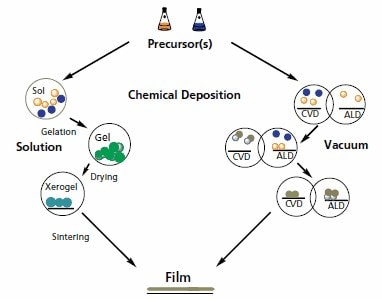Chemical Deposition Techniques in Materials Design
Viktor P. Balema, Dr.
Material Matters 2006, 1.3, 3.
During the last decade, chemical deposition techniques have played an exceptionally important role in the design and manufacture of novel advanced devices. Physical deposition techniques, such as molecular beam epitaxy (MBE), physical vapor deposition (PVD) or sputtering, have been used for these applications. However, they suffer from limitations such as poor conformality, low throughput, restricted directional variation, and reduced compositional control. All of these issues can and have been addressed using chemical deposition techniques which offer additional advantages such as ultrathin film growth. This is especially the case when layered inorganic materials are assembled in order to create an electronic chip or to modify the surface of a tool for improved performance and durability. Currently, two groups of different, yet related, techniques dominate the field. The first group comprising Chemical Vapor Deposition (CVD) and Atomic Layer Deposition (ALD) uses a gas phase to transport volatile molecules to the surface serving as a substrate. The second group of deposition techniques, called Chemical Solution Deposition or Sol-Gel Processing, uses a liquid phase as the mass transfer media.
There is a fundamental resemblance between these two groups - the way that the final material is created. In both cases, molecules of chemical compounds serving as precursors are delivered to the substrate surface and chemically modified to obtain the desired film. It should be noted, however, that the chemical transformations of the precursor in the case of CVD/ALD can occur in the gas phase and at the gassolid interface, while in sol-gel processing it is carried out in solution (Figure 1). In the CVD/ALD approach, the chemical modification of the precursor is usually achieved via thermal conversion of precursor molecules and/or their reactions with molecules of other volatile precursors, or reactive gases such as oxygen or hydrogen.1-3 Sol-gel processing consists of a sequence of chemical transformations in solution and solidstate. They include formation of a colloidal suspension in an appropriate solvent (sol), gelation (gel), evaporation of the solvent (drying), and thermal treatment (sintering). 4-7

Figure 1Schematic illustrating chemical deposition of ceramic films.
Materials with a layer thickness below 1 μm are called thin films, while thicker layers, especially those exceeding dimensions of a transistor in an electronic chip, are defined as thick films. Both thin and thick films play an exceptionally important role as elements of electronic and optical devices, computer memory chips, and in other related applications. Additionally, in the case of ceramic films, properties such as chemical resistivity and hardness enable their use as coatings on substrate materials and cutting tools for protection against corrosion, oxidation, and wear.
Typically, CVD/ALD techniques are methods of choice for the deposition of thin films on inorganic substrates, while solution-based sol-gel approaches are considered when thick films or nano-powders are desired. Also, lower equipment cost and reasonably good conformality of coatings may make sol-gel a low-cost alternative to CVD/ALD. However, the ALD approach may be required for the preparation of uniform conformal films on complex surfaces such as those with high aspect ratios.
Usually, the nature of the deposition process determines the way in which the thickness of the film is controlled. Thus, in conventional CVD, the film growth depends on the deposition time, while in ALD it is controlled by the number of deposition cycles.1-3 In sol-gel processing, the films are created using two major approaches – spin coating or dip coating. In the first case, the substrate is spun at an angular speed ω and the precursor (sol) is directed onto its surface along the rotation axis. The thickness (h) of the created films depends on a complex combination of the sol’s properties and the rotation speed of the substrate. In practice, they can be predicted using a semi-empirical formula
h = AωΒ
where A and B are empirical coefficients. The dip coating process consists of the successive dipping and withdrawal of the substrate in and out of the solution. The thickness of the film obtained in one dipping-withdrawal cycle is determined8 by the properties of the solution, i.e. viscosity (η), density (ρ), surface tension (σ) and the withdrawal speed (n) :
h = 0.945{(nη)2/3/ (gρ)1/2σ1/6}
While CVD/ALD techniques produce thin films of high uniformity and metal purity, sol-gel processing provides a unique and simple approach to tuning the film’s chemical composition and morphology. Sol-gel processing can also offer a less expensive alternative to CVD/ALD, especially if in situ doping is required.
An example, when solution processing has been used successfully as an alternative to CVD/ALD was in the preparation of silicon thin-film transistors where the deposition of a polycrystalline silicon used a liquid precursor, cyclopentasilane (Si5H10).9 The grain size in the films obtained were found to be as low as 300 nm, comparable to that for films typically prepared by CVD.
An illustration where CVD is clearly preferred over solventbased processing, is the deposition of magnesium aluminum spinel (MgAl2O4). Magnesium aluminum spinel is an excellent material for refractory applications because of its mechanical strength, chemical resistance, and low density. Also, it shows potential as a humidity sensor and as a buffer layer for the growth of oxide superconductors. Thin films of MgAl2O4 have been successfully prepared by CVD using Mg-Al precursors such as MgAl2(OPr-i)8 or MgAl2(OBu-t)8. Sol-gel processing was employed for this application using a similar intermediate, MgAl2[(OCH2CH2)N]3, resulting in micro-porous powders.10,11 Remarkably, certain groups of precursors, such as metal alkoxides, for example, can be used successfully in both CVD/ ALD and Chemical Solution Deposition/Sol-Gel Processing of metal-oxide films and nano-structures.12-14
Thus, when used to the best of their abilities, Chemical Vapor and Solution Deposition techniques are excellent tools, to enable the design of a broad range of materials with predefined dimensions, morphology and properties.
Acknowledgements
I would like to thank Dr. S. Jasty, Dr.A.Korolev, Dr. M. Stender, and S. Adam for discussions and help in the preparation of the manuscript.
References
To continue reading please sign in or create an account.
Don't Have An Account?